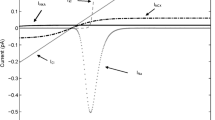Abstract
The release of H+ during the oxalate-supported Ca2+ uptake in sarcoplasmic reticulum vesicles is kinetically coincident with the initial phase of Ca2+ accumulation. The Ca2+ uptake is increased and the H+ release is decreased in the presence of KCl and other monovalent chloride salts as expected for a H+-monovalent cation exchange. The functioning of the Ca2+-pump is disturbed by the presence of potassium gluconate and, to a lesser extent, of choline chloride. These salts do not inhibit the ATPase activity of Ca2+-permeable vesicles, suggesting a charge imbalance inhibition which is specially relevant in the case of gluconate. Therefore, K+, and also Cl−, appear to be involved in secondary fluxes during the active accumulation of Ca2+. The microsomal preparation seems homogeneous with respect to the K+-channel, showing an apparent rate constant for K+ release of approximately 25 s−1 measured with the aid of86Rb+ tracer under equilibrium conditions. A Rb+ efflux, sensitive to Ca2+-ionophore, can be also detected during the active accumulation of Ca2+. The experimental data suggest that both monovalent cations and anions are involved in a charge compensation during the Ca2+ uptake and H+ release. Fluxes of these highly permeable ions would contribute to cancel the formation of a resting membrane potential through the sarcoplasmic reticulum membrane.
Similar content being viewed by others
References
Chiesi, M., and Inesi, G. (1980).Biochemistry 19, 2912–2918.
Dupont, Y., and Moutin, M. J. (1987).Methods Enzymol. 148, 675–683.
Ebashi, S., and Endo, M. (1968).Prog. Biophys. Mol. Biol. 18, 125–183.
Eletr, S., and Inesi, G. (1972).Biochim. Biophys. Acta 282, 174–179.
Fleischer, S., and Inui, M. (1989).Annu. Rev. Biophys. Biophys. Chem. 18, 333–364.
Garcia, A. M., and Miller, C. (1984).J. Gen. Physiol. 83, 819–839.
Ide, T., Morita, T., Kawasaki, T., Taguchi, T., and Kasai, M. (1991).Biochim. Biophys. Acta 1067, 213–220.
Inesi, G., and Scarpa, A. (1972).Biochemistry 11, 356–359.
Inesi, G., Lewis, D., Nikic, D., Hussain, A., and Kirtley, M. E. (1992) InAdvances in Enzymology and Related Areas Molecular of Biology (Meister, A., ed.), Vol. 65, Wiley, New York, pp. 185–215.
Kometani, T., and Kasai, M. (1978).J. Membr. Biol. 41, 295–308.
Levy, D., Seigneuret, M., Bluzat, A., and Rigaud, J. L. (1990).J. Biol. Chem. 265, 19524–19534.
Lin, T., and Morales, M. F. (1977).Anal. Biochem. 77, 10–17.
Lowry, O. H., Rosebrough, N. J., Farr, A. L., and Randall, R. J. (1951).J. Biol. Chem. 193, 265–275.
MacLennan, D. H. (1990).Biophys. J. 58, 1355–1365.
Madeira, V. M. C. (1978).Arch. Biochem. Biophys. 185, 316–325.
Madeira, V. M. C. (1984).Biochim. Biophys. Acta 769, 284–290.
McKinley, D., and Meissner, G. (1978).J. Membr. Biol. 44, 159–186.
Meissner, G. (1975).Biochim. Biophys. Acta 389, 51–68.
Meissner, G. (1981).J. Biol. Chem. 256, 636–643.
Meissner, G., and McKinley, D. (1976).J. Membr. Biol. 30, 79–98.
Meissner, G., and Young, R. C. (1980).J. Biol. Chem. 255, 6814–6819.
Orlowski, S., and Champeil, P. (1991).Biochemistry 30, 352–361.
Riollet, S., and Champeil, P. (1987).Anal. Biochem. 162, 160–162.
Rousseau, E., Roberson, M., and Meissner, G. (1988).Eur. Biophys. J. 16, 143–151.
Somlyo, A. V., Shuman, H., and Somlyo, A. P. (1977).Nature (London)268, 556–558.
Tanifuji, M., Sakabe, M., and Kasai, M. (1987).J. Membr. Biol. 99, 103–111.
Yamaguchi, M., and Watanabe, T. (1988).Methods Enzymol. 157, 233–240.
Yu, X., Carroll, S., Rigaud, J. L., and Inesi, G. (1993).Biophys. J. 64, 1232–1242.
Author information
Authors and Affiliations
Rights and permissions
About this article
Cite this article
Soler, F., Sanchez-Migallon, P., Gomez-Fernandez, J.C. et al. Interdependence of H+ and K+ fluxes during the Ca2+-pumping activity of sarcoplasmic reticulum vesicles. J Bioenerg Biomembr 26, 127–136 (1994). https://doi.org/10.1007/BF00763224
Received:
Accepted:
Issue Date:
DOI: https://doi.org/10.1007/BF00763224




